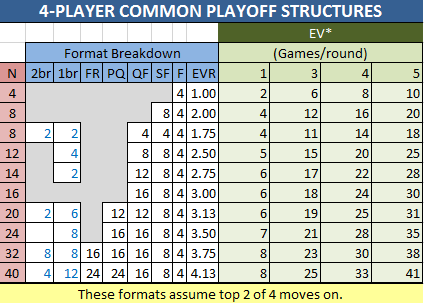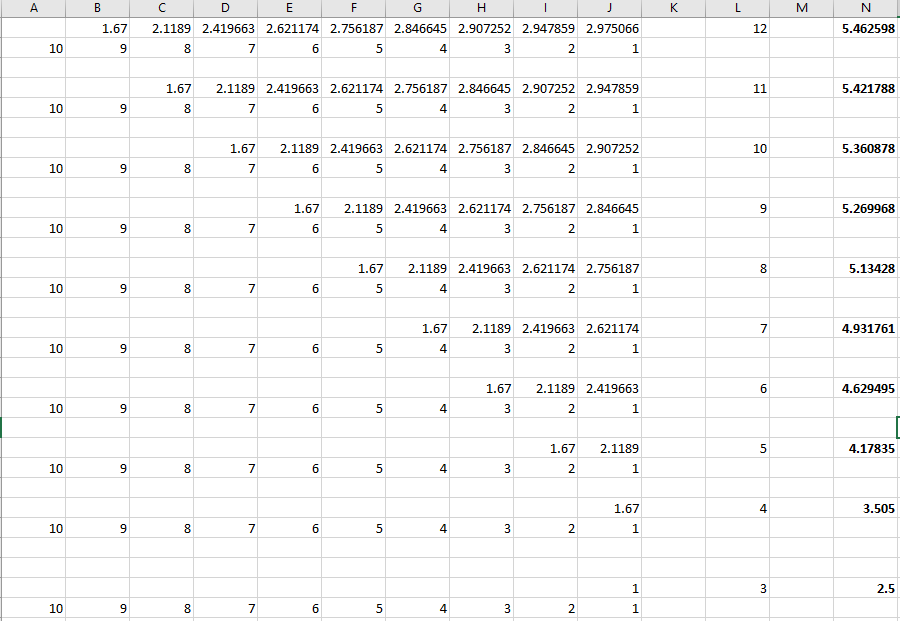So, do you get it? Because I don’t. Here’s the issues I’m having:
There’s quite obviously something wrong with the 4pl, 1ko column. The numbers don’t even match the numbers in the TGP Guide. @pinwizj any idea what happened there? Just look at the first row: 4 people play a single game, that’s it. How is this 3 EV*? My guess is that there was a mistake in the table, which has been fixed at some point, so an updated version should exist somewhere which the TGP Guide is actually based on.
The TGP Guide says:
3 player groups, 1 player eliminated per round until final 4 players remain (assumes 1 game for final 4).
Looking at the table, I don’t think that’s correct, and it should actually be until final 3 players remain (assumes 1 game for final 3). Same goes for 2-player groups.
The reason is this: Look at the first row of 3pl, 1ko, it says Max 2, meaning the winner of the tournament could have played a maximum of 2 games. That’s not possible if the final game is supposed to be played with 4 players, and there’s only 4 players total in the tournament.
Even for the columns other than the 4pl, 1ko one, and assuming the correct number of players in the final game, the numbers don’t exactly match up with mine. @dbs are you still around and can maybe shed some light on how you did it? Let’s look at the first row of 3pl, 1ko for example. Here’s how I would calculate the EV+:
-
There’s 4 players total, and each one contributes to the expected number of games played by the winner based on this: If they win the tournament, how many games will they have played? And what’s the probability that they do actually win the tournament?
-
One player enters the tournament in the final game. There’s 3 people in that game, so for the probability to win it (and thus the tournament) we can assume 1/3. That player will only have played 1 game in the end, so they contribute 1/3 * 1 to the EV. Since it’s a 3-player game, there’s a 1.5x multiplier, so they contribute 1/3 * 1 * 1.5 to the EV+, which is 0.5.
-
For the other 3 players it’s like this: In order to win the tournament, they have to advance a round (don’t come in last in a 3-player game, so a probability of 2/3) and then win the last game (1/3, as before), so a total probability of 2/3 * 1/3. If any of them does that, they will have played 2 games in the end, so that’s a contribution of 2/3 * 1/3 * 2 to the EV. This applies to 3 players total, so in total those 3 players contribute 2/3 * 1/3 * 2 * 3 to the EV. 3-player multiplier again, so combined they contribute 2/3 * 1/3 * 2 * 3 * 1.5 to the EV+, which is 2.
-
So, the sum of all players’ contributions to the EV+ is 2.5, meaning the EV+ is 2.5.
-
The table says 2.3, though—how do you get that? I mean, in order to calculate the EV, a probability for each player to win / not lose a game has to be assumed. I gave all players an even probability to win each game, which seems reasonable, and it’s the same assumption the tables for the bye playoff structures seem to make, so I guess you’re doing the same? What’s the difference then?
The table seems inconsistent with the Common Playoff Structures table.
Some formats are actually identical, but they are listed with different EV values in different tables. E.g. row 5 (8 players) in the 4p, 2ko ladder table plays identical to row 3 (8 players, 2 x 2 byes, 2 x 1 bye) in the 4-player common playoff structures table, but the first lists an EV* of 3.6, while the second lists an EVR of 1.75, so an EV* of 3.5 (rounded up to 4 in the table).
Here’s that playoff table for comparison:


